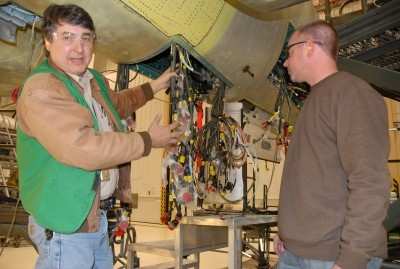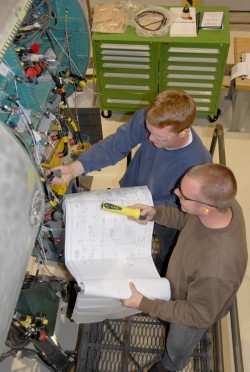Work Will Extend The Life Of The Aircraft For Several
Years
 A new rewire flight at Robins Air
Force Base, GA, is playing a key role in keeping the aging F-15
Eagle flying for years to come. The flight will perform a complete
rewire on 122 F-15s during the next five years. The rewiring will
be done on C and D models, and when complete, the flight will spend
at least another five years working on E models.
A new rewire flight at Robins Air
Force Base, GA, is playing a key role in keeping the aging F-15
Eagle flying for years to come. The flight will perform a complete
rewire on 122 F-15s during the next five years. The rewiring will
be done on C and D models, and when complete, the flight will spend
at least another five years working on E models.
The reason for the rewire is that the insulation on the existing
wire is getting brittle and causing shorts, said Keith Gilstrap,
the rewire flight chief. Although it has not caused any crashes, it
has led to a significant amount of field repair time and false
troubleshooting, as technicians try to figure out why aircraft
systems fail intermittently, he said.

Keith Gilstrap (L), Robert Lamb
Work on the first plane began Nov. 13,
2009, and, when fully ramped up, they will be working on seven
planes at a time, Mr. Gilstrap said. The flight currently has four
planes in the hangar. All of the planes are coming to Robins AFB
for programmed depot maintenance, with the rewire being done in
conjunction with that. Robins AFB mechanics did an F-15 rewire in
the early 1990s, but at that time it was done in the same hangar as
the PDM.
The difference this time is a "cellular concept," in which the
rewire will be done in a separate building with electricians and
mechanics focused solely on that task. Mr. Gilstrap said that
approach will lead to a more efficient workflow. The rewire is
expected to take 72 to 77 days per plane. Mr. Gilstrap explained
that in normal PDM, electricians would inspect the wiring but
replace it only as needed. In the rewire program, all but a few
already updated wires will be removed and replaced.
A total of 120 people will be working in the flight when it
reaches full capacity, including 47 newly hired electricians. The
rest of the crew is being shifted from PDM work. "This is an all
volunteer force," Mr. Gilstrap said. "We did not have to tell one
person to come here. They wanted to do something new and different
and they wanted to be on the ground floor of a new facility and a
new workload."
In addition, the rewiring work will prove its worth in savings.
"It is really going to save millions of dollars," he said. "It's
going to save an untold amount of man hours out in the field, in
troubleshooting and repair."

Eric Bickett (L), Robert Lamb
Although the first production plane
arrived in November, the flight had already tested the process on
three planes in a validation and verification process. They rely on
wiring diagrams to figure out the arrangement of the massive amount
of wires and connectors on the plane. Those working on the project
said they enjoy the challenge. "You get to learn a lot about the
aircraft," said Eric Bickett, an aircraft mechanic.
The planes come to the hangar basically stripped down to the
fuselage, with the wings, engines and avionics removed. After the
rewire is complete, the wires are all connected to a large,
custom-built machine called a wire integrity tester. The tester has
a wire that attaches to each connection on the plane, and it
virtually assures that the job has been done correctly before the
plane is reassembled. Mr. Gilstrap said the first plane is
scheduled to go on the tester Jan. 21.
 NTSB Final Report: Patriot Aircraft LLC CX1900A
NTSB Final Report: Patriot Aircraft LLC CX1900A Aero-News: Quote of the Day (12.06.25)
Aero-News: Quote of the Day (12.06.25) ANN's Daily Aero-Term (12.06.25): High Speed Taxiway
ANN's Daily Aero-Term (12.06.25): High Speed Taxiway ANN's Daily Aero-Linx (12.06.25)
ANN's Daily Aero-Linx (12.06.25) Airborne-NextGen 12.02.25: Honda eVTOL, Arctus High-Alt UAS, Samson Patent
Airborne-NextGen 12.02.25: Honda eVTOL, Arctus High-Alt UAS, Samson Patent





